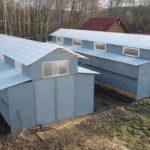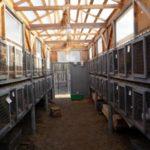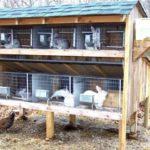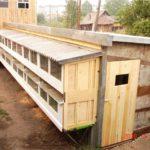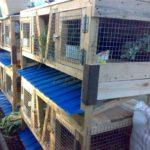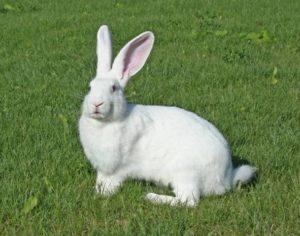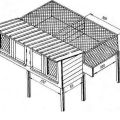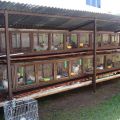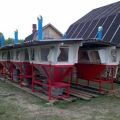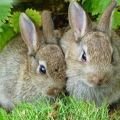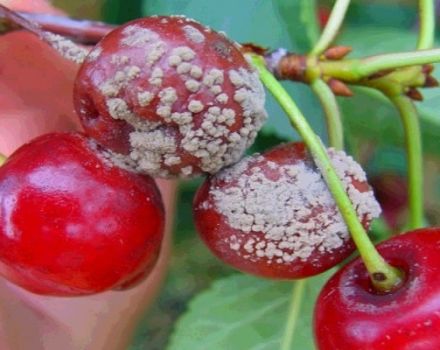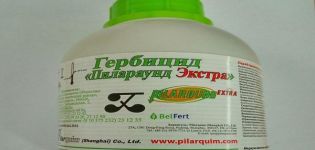Schemes and drawings of sheds for rabbits, instructions for making your own hands
Sheds are special structures for rabbits, in which they can be from the moment of birth until slaughter. These are structures that look like cells arranged in one row. Some sheds have 2 or 3 tiers. The cages are stacked on top of each other to save space. The structure itself is placed indoors or outdoors. It is advisable to build sheds if there are more than ten rabbits on the farm.
What are sheds?
It is customary to keep rabbits in cages that can be placed outdoors in the open air or under a canopy, as well as indoors. Animals are kept in one- or two-section structures. The recommended planting density is 0.5-0.7 sq. meters per adult rabbit. Youngsters are grown in group cages.
To keep animals, some rabbit breeders build sheds. These are blocks of cells, only located in one continuous row. Each section is separated by a partition. To save space, sheds are made in 2-3 tiers. The length of each individual block for an adult rabbit is 60-90 centimeters, the length of the cage for group keeping of young animals is 1.3 meters. The shed itself consists of several sections fenced off from each other. The length of the structure depends on the number of cells. It can be from 2 to 30 meters or more.
For sheds, consisting of 10 or more cells, a separate room is built. The rabbitry is made of bricks, foam blocks, wood, corrugated board, metal profile. In regions with a warm climate, rabbits are kept outdoors in wooden sheds under a canopy.
Constructions with units for keeping animals can be placed in several rows. It all depends on the number of livestock and the size of the farm. The sheds themselves are made from wooden boards or from a mesh with a fine mesh and metal pipes, slats, profiles.

Features of shed content
Rabbit breeders who want to raise rabbits in sheds will have to spend a little. After all, materials and, of course, money are needed to make cages and equip a shed or build a rabbitry. Over time, the funds for the construction of the shed system will pay off. You can make a structure from scrap materials. In this case, the cost of making cells will be minimal.
How to make a DIY rabbit shed
You can make a shed design yourself.Every rabbit breeder has the right to come up with his own model. The main thing is to remember that all sections of the shed design, that is, the cages for keeping rabbits, are located in one row. Depending on the number of pets, sheds are made in 1, 2 or 3 tiers.
Size and number of cells
First of all, you need to decide on the size of the shed. The total size of the structure depends on the number of sections, that is, on the number of cells. For single keeping of an adult rabbit, a block 60-80 cm long is needed. If the cage has a stern and nesting part, then it is made several centimeters longer and divided into two sections, leaving a small gap between them. Young animals are kept in group cages, their length is at least 1.3 meters. The width and height of one block is 50-70 cm.
Suppose the shed will consist of 8 cells arranged in 2 tiers. Four of them will be single-section, another four will be two-section. One row can contain two small and two large cells. Space for a pallet is left between the first and second tier. The shed itself will stand at a distance of 60 cm from the floor.
Having decided on the model of the structure, they draw drawings and, on their basis, calculate the amount of materials. Shed is a structure in which you can make one common back wall. The blocks are fenced off from each other with partitions. In the front part, separate doors are installed for each section. The total length of such a structure is about 4 meters. The height of the two-tiered shed is 2 meters. The number of blocks in one row is 4 pieces. The distance to the ground is 60 cm. The height of the cage is 50 cm. These are approximate dimensions for a 8 block shed. Each breeder can come up with his own model. The main thing is that the structure must be durable, spacious and warm.
Required tools and materials
To make a shed, you will need the following tools and materials (optional):
- wooden boards;
- metal mesh with a fine mesh;
- wooden slats or metal profiles, pipes for the frame;
- galvanized sheet metal for the pallet;
- planks, bars;
- roof decking (waterproofing material, slate, polycarbonate);
- grinder, screwdriver;
- nails, screws;
- hammer, hacksaw, metal scissors;
- roulette, level.

Step-by-step instruction
Stages of construction of the shed:
- a rectangular frame is made of wooden slats or metal profiles for cells arranged in one row in 1 or 2, 3 tiers;
- the first tier should be 60 cm above the ground;
- the back wall of the frame is sheathed with wood or metal mesh;
- partitions are made of wood or mesh between the cells;
- the floor is made of wooden slats, leaving gaps, or from a fine mesh, lining a rubber mat;
- between the upper and lower tier, pallets or trays for feces made of wood or sheet metal are inserted;
- for each cage, a separate door is made from a metal mesh and a rectangular base;
- the door is attached to the frame with hinges and a latch or lock is screwed to it;
- the shed is covered with a retractable roof, which is installed under a slope.
Arrangement of the shed
Each cage should contain a grass and hay nursery, a feeder for finely chopped vegetables and grains, and a drinking bowl for water. Usually, the sennik is made of wire or wooden slats, boards, plywood and carried out to the perimeter of the block, that is, installed on the front (side) wall or on the door.
The drinker can be bought ready-made, it is an ordinary plastic, ceramic or metal container for water. They put her in a cage. The feeder can be made of wood or bought ready-made (bunker, plastic) in the store. She must also stand inside each cell.
If the floor is made of metal mesh, then a rubber mat is placed on top of it, otherwise the animals will rub calluses on their paws. Usually mesh structures are installed indoors. Sheds are made of wood for the street. In winter, straw is laid on the floor in wooden cages under a canopy.
Subtleties of care
Rabbits are animals that must be fed on a daily basis. They are given food 3 times a day. Rabbits eat grass, hay, finely chopped vegetables (carrots, pumpkin, beets), beet tops, cabbage leaves, tree branches. The animals are also given grain mixtures (in a minimum amount), boiled potato mash - from such feed they quickly recover.

Rabbits are grown for meat for 6-10 months. Some of the healthiest individuals are kept for breeding. Sexual maturity in animals occurs at 4 months of age, but they mate no earlier than 6 months. For breeding, you need to leave several females and one male, which is not a relative of them, otherwise the offspring will be weak.
The sheds in which the rabbits are kept must be cleaned daily. Animals should not be kept in mud, on a wet mat. In unsanitary conditions, rabbits will start to get sick, refuse to eat, and may even die. It should always be clean, dry, warm in sheds. Wooden structures that are in the open air must be protected from precipitation with a roof covered with waterproofing materials or slate. In winter, such sheds can be insulated with slabs of shavings and veneer, and one common shed can be built on top.
The inside of the cage should be dark but spacious. Rabbits should have plenty of room to be active. In fully open and transparent structures, animals slowly gain weight. It is advisable to install mesh cages in a room with a minimum number of windows.
It is better to build two-section structures for rabbits. These large blocks have a darkened rest nest with a small opening and a stern section (with a mesh door or transparent front wall) that is suitable for activity and eating. In summer, it is advisable to keep the animals in enclosures so that they have the opportunity to be in the sun and eat green grass.

